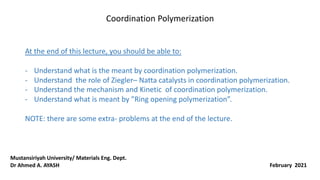
Catalytic polymerization and types of polymerization
- 1. Coordination Polymerization At the end of this lecture, you should be able to: - Understand what is the meant by coordination polymerization. - Understand the role of Ziegler– Natta catalysts in coordination polymerization. - Understand the mechanism and Kinetic of coordination polymerization. - Understand what is meant by ”Ring opening polymerization”. NOTE: there are some extra- problems at the end of the lecture. February 2021 Mustansiriyah University/ Materials Eng. Dept. Dr Ahmed A. AYASH
- 2. SUMMARY Polymerization of a Polymer Addition Polymerization (or Chain-Growth) (Homopolymer) Condensation Polymerization (or Step-growth) Free-Radical polymerization Ionic polymerization Coordination polymerization Anionic polymerization Cationic polymerization Reaction between two monomers and usually there is a small molecule splitting off (e.g. water) Usually, there is a single monomer and addition process occurs. However, note if there are more than two types of monomer reacting together by addition polymerization , the process is called “ copolymerization “ and the obtained polymer is called “ copolymer “.
- 3. In the early 1950's a major new polymerization technique was discovered that led to the production of polymers with unusual stereospecific structures. Although there were earlier indications of this type of polymerization (Schildkne'cht 1947), the field actually came into existence with the work of Ziegler (1955) and Natta (1955), who developed new polymerization catalysts with unique stereoregulating powers. Their Nobel Prize addresses (Ziegler 1964; Natta 1965) form excellent introductions to the field. COORDINATION POLYMERIZATION
- 4. A coordination polymer is an inorganic or organometallic polymer structure containing metal cation centers linked by ligands ( atom or group of atoms will formally donate a lone pair of electrons to a metal cation and form a coordination complex via a Lewis acid/ base relationship). More formally a coordination polymer is a coordination compound with repeating coordination entities extending in 1, 2, or 3 dimensions. Some Features: 1. Coordination polymerization is far from simple in terms of mechanism, kinetics, or application. 2. The most important catalysts are solids, leading to heterogeneous polymerization systems, but soluble catalyst systems are known. Additional complications to the study of coordination systems arise because the same catalysts, under other conditions, can initiate polymerization by cationic, anionic, or even free-radical mechanisms. 3. Quite often coordination polymerization is carried out using a catalyst in the form of a slurry of small solid particles in an inert medium (a fluidized-bed process) or a supported solid catalyst.
- 5. The Ziegler-Natta or, often, Ziegler catalysts have the remarkable property of' polymerizing a wide variety of monomers to linear and stereoregular polymers. Ethylene is polymerized to a highly linear chain, in contrast to the products of' radical polymerization. Polypropylene may be made in either the isotactic or syndiotactic form, but higher or-olefins yield only isotactic polymers. Dienes such as butadiene may be polymerized to products that are almost exclusively cis-1,4, trans-1,4, depending on choice of catalyst and conditions. Many other examples exist. List of common Ziegler-Natta catalysts Ziegler– Natta catalysts The metals that are more frequently found as components of Ziegler– Natta catalysts are some light elements of groups I–III of the periodic table (e.g., Li, Mg, Al), present as organometallic compounds and halides, or other derivatives of transition metals of groups IV–VIII (e.g., Ti, V, Cr, Mo, Co, and Ni).
- 6. A typical example is the product(s) of the reaction between triethylaluminum and titanium tetrachloride. The composition of the product is not well defined but is believed to be either an alkylated metal halide (monometallic I) or a bimetallic complex involving a bridge between the two metals (II). 1. Mechanisms
- 9. 2. Kinetic Considering here the important but complex case of heterogeneous polymerization, we denote the surface of the transition-metal compound by a heavy bar ,the metal alkyl by AR, and the monomer by M. The following reactions me pertinent: Adsorption of AR from solution to form the active site, and of M from solution,
- 10. Other transfer reactions are possible. Termination of the kinetic chain can occur by several reactions, an example being that with monomer to form an inactive site:
- 13. RING-OPENING POLYMERIZATION Polymers may be prepared by routes involving ring opening, which must be classed stoichiometrically as addition, since no small molecule is split off in the reaction. Some typical examples are given in Table below. The polymerization of these compounds has some aspects of both chain and step polymerization as far as kinetics and mechanism are concerned. It resembles chain polymerization in that it proceeds by the addition of monomer to growing chain molecules. However, the chain-initiating and subsequent addition steps may be similar and proceed at similar rates; if so, these are not chain reactions in the kinetic sense. As in stepwise polymerization, the polymer molecules continue to increase in molecular weight throughout the reaction.
- 14. Extra – Problems Q1 * * J. Am. Chem. Soc. 74, 2027 (1952)
- 16. Q2